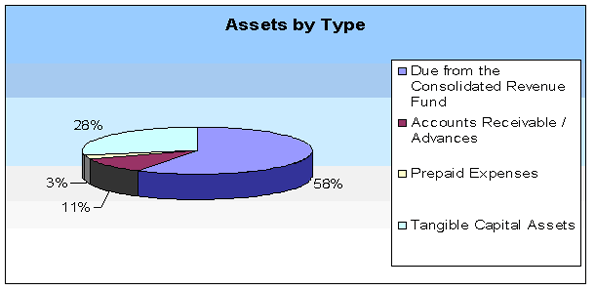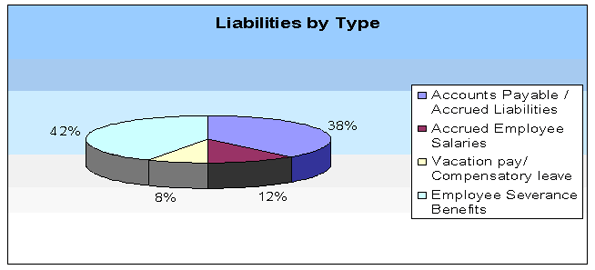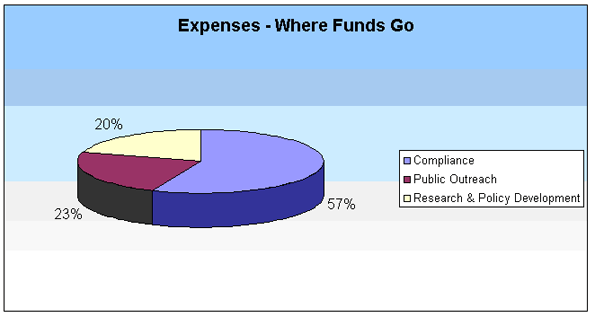Common menu bar links
Breadcrumb Trail
ARCHIVED - Office of the Privacy Commissioner of Canada
 This page has been archived.
This page has been archived.
Archived Content
Information identified as archived on the Web is for reference, research or recordkeeping purposes. It has not been altered or updated after the date of archiving. Web pages that are archived on the Web are not subject to the Government of Canada Web Standards. As per the Communications Policy of the Government of Canada, you can request alternate formats on the "Contact Us" page.
Section III: Supplementary Information
This section presents the financial highlights for 2008-2009 and other items of interest. Audited financial statements can be found on the OPC website.
3.1 Financial Highlights
| % Change | 2008-2009 ($000) |
2007-2008* ($000) |
|
|---|---|---|---|
| Total Assets | 60% | 5,259 | 3,283 |
| Total Liabilities | 76% | 7,110 | 4,044 |
| Total Equity of Canada | 143% | (1,851) | (761) |
| Total | 60% | 5,259 | 3,283 |
| * Restated | |||
| % Change | 2008-2009 ($000) |
2007-2008* ($000) |
|
|---|---|---|---|
| Total Expenses | 37% | 25,474 | 18,584 |
| Net Cost of Operations | 37% | 25,474 | 18,584 |
| * Restated | |||

Total assets were $5.259M at the end of 2008-2009, an increase of $1.976M (60 percent) over the previous year’s total assets of $3.283M. Of the total assets, $3.079M (58 percent) were due from the Consolidated Revenue Fund. Accounts receivable and advances represented $0.554M (11 percent) while prepaid expenses and tangible capital assets represented 3 percent and 28 percent of total assets respectively.

Total liabilities were $7.110M at the end of 2008-2009, an increase of $3.066M (76 percent) over the previous year’s total liabilities of $4.044M. Employee severance benefits represented the largest portion of liabilities at $2.986M or 42 percent of the total. Accounts payable and accrued liabilities represented a slightly smaller portion of the total liabilities, at $2.70M or 38 percent). Vacation pay and Compensatory leave and accrued employee salaries accounted for 8 percent and 12 percent of total liabilities, respectively.

Total expenses for OPC were $25.474M in 2008-2009. The largest share of the funds, $14.352M or 57 percent, was spent on compliance activities, while public outreach efforts represented $5.938M, or 23 percent of total expenses. Research and policy development accounted for the remainder of the expenditures, at $5.184M, or 20 percent of the total.
Audited Financial Statements
Information on OPC’s audited financial statements can be found at the following link: http://www.priv.gc.ca/information/an-av_e.cfm#contenttop
3.2 Other Items of Interest: Legislation Administered by the Privacy Commissioner
| Privacy Act | R.S., 1985, ch. P-21, amended 1997, c.20, s. 55 |
|---|---|
| Personal Information Protection and Electronic Documents Act | 2000, c.5 |
Statutory Annual Reports, other Publications and Information
Statutory reports, publications and other information are available from the Office of the Privacy Commissioner of Canada, 112 Kent Street, 3rd Floor, Ottawa, ON K1A 1H3; tel.: (613) 995-8210, and on the OPC's website at www.priv.gc.ca
1 The variance of $1.152M between Planned Spending and Main Estimates represents funds that had been earmarked within the Government of Canada fiscal framework for the implementation of the Federal Accountability Act. Subsequently, the OPC submitted a business case in 2008, which triggered supplementary funding, as reflected in the Total Authorities.
2 The TBS scale for performance status refers to the proportion of the expected level of performance (as evidenced by the indicator and target or planned activities and outputs) for the priority or result identified in the corresponding Report on Plans and Priorities that was achieved during the fiscal year. The ratings are: exceeded – More than 100 percent; met all – 100 percent; mostly met – 80 to 99 percent; somewhat met – 60 to 79 percent; and not met – less than 60 percent.
3 Type is defined as follows: previous –committed to in one of the past two Reports on Plans and Priorities (RPP); ongoing – committed to at least three fiscal years prior to this RPP; and new – newly committed to in this RPP.
4 http://www.tbs-sct.gc.ca/pubs_pol/ciopubs/pia-pefr/siglist-eng.asp
5 As part of a major review of its inquiry and complaint investigation processes, to be completed in 2009-2010, the OPC will set new service standards against which to compare turnaround times. Timeliness of responses will be calculated by: (i) the proportion of complaints completed within service standards and (ii) the reduction of the backlog. In the meantime, actual turnaround times are presented in 2008-2009, along with a report on the backlog.
6 Adjusted to a new definition of backlog adopted as of April 1, 2008 to include all files older than a year from acceptance.
7 The three audits completed in 2008-2009 were: (1) Privacy Management Frameworks of Selected Federal Institutions (Feb. 12, 2009) http://www.priv.gc.ca/information/pub/ar-vr/pmf_20090212_e.pdf; (2) Privacy Audit of Canadian Passport Operations (Dec. 4, 2008) http://www.priv.gc.ca/information/pub/ar-vr/pc_20081204_e.pdf; (3) Audit of Equifax Canada Inc. (April 2008).
8 This performance indicator was included in the 2008-2009 RPP but has since been modified so as to present some private-sector data only once every other year. Because the OPC last polled a sector of private industry in 2007-2008, the next survey will be conducted in 2009-2010. In the public sector, awareness is now assessed based on the quality of PIAs submitted for review. This year’s DPR reports on some information related to public-sector organizations, using the 2009 Audit of the Privacy Management Frameworks of Selected Federal Institutions http://www.priv.gc.ca/information/pub/ar-vr/pmf_20090212_e.asp and the 2007 Audit: Assessing the Privacy Impacts of Programs, Plans, and Policies (http://www.priv.gc.ca/information/pub/ar-vr/pia_200710_e.cfm).
